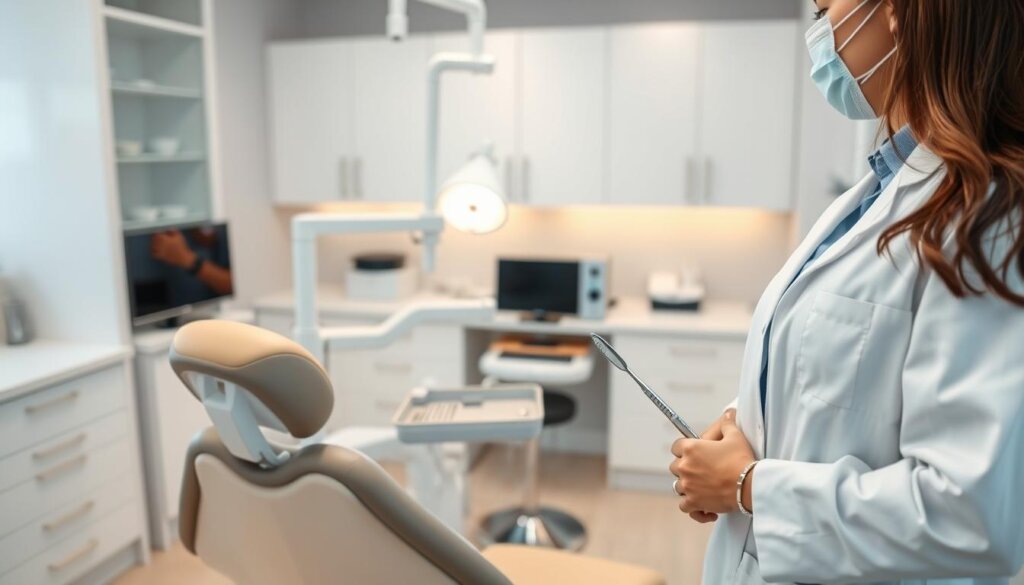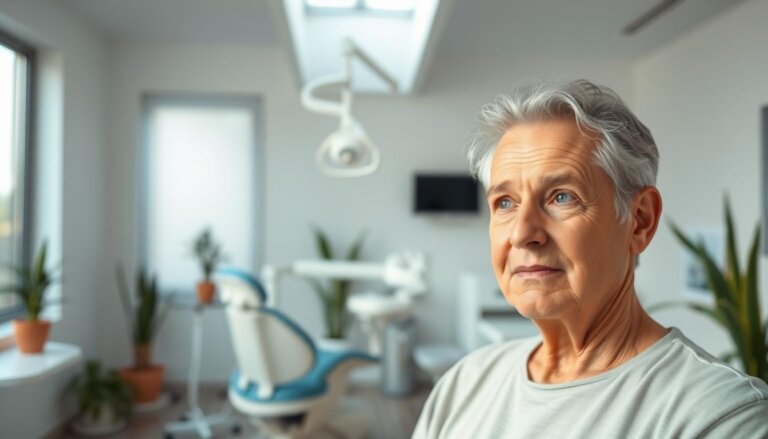How Long After a Dental Cleaning Can I Eat or Drink?
Every year, nearly 100 million American adults miss their dental cleanings. This is according to the American Dental Association. So, after getting a dental cleaning, how long can you eat or drink?
Experts say to wait 30 minutes to 1 hour. This time lets fluoride bond to your teeth. It also helps reduce sensitivity in your teeth and gums. This article will explore the science behind these guidelines.
It will also tell you how long you can eat or drink after a dental cleaning without disrupting your day.
Key Takeaways
- Waiting at least 30 minutes helps fluoride settle on freshly cleaned teeth.
- Sensitivity may occur in both teeth and gums right after treatment.
- Soft foods and moderate temperatures reduce irritation.
- A rushed meal can limit the benefits of fluoride application.
- Guidance from a licensed dentist supports a faster return to normal eating.
Understanding Dental Cleanings
Many people want to keep their teeth white and healthy. A dental cleaning removes plaque, making teeth stronger against decay. This helps keep your mouth healthy for a long time.
What Happens During a Dental Cleaning?
First, dentists check for any problems. They use special tools to get rid of plaque and tartar. Then, they polish your teeth to make them smoother.
Some places also use fluoride or sealants for extra protection. This helps prevent gum problems and improves your mouth’s health.
A few key steps are:
- Checking teeth and gums for early signs of disease
- Removing stubborn tartar from hard-to-reach places
- Polishing teeth to enhance brightness and reduce surface stains
Importance of Maintaining Oral Hygiene
Regular dental cleaning is key to good oral health. It helps keep gums healthy and prevents tooth loss. Brushing, flossing, and regular dental visits are important.
These habits help you have a confident smile for years to come.
Immediate Aftermath of Dental Cleaning
Teeth and gums might feel tender after a dental cleaning. This sensitivity is usually short-lived as they heal.
Common Sensations You Might Experience
Some people might notice gum irritation. Others might feel a brief zing from cool air or sweet drinks. These feelings usually go away:
- Sore or inflamed gums
The Effect of Anesthesia on Eating and Drinking
Local anesthetic helps reduce pain but might make things feel numb for a few hours. It’s important to be careful not to bite too hard. Dentists often advise being mindful of food textures to avoid discomfort when eating after a dental cleaning.
| Possible Sensation | Suggested Steps |
|---|---|
| Gum Tenderness | Rinse with a mild salt solution and adopt gentle brushing habits |
| Temporary Sensitivity | Switch to lukewarm drinks and choose soft foods |
General Recommendations for Eating and Drinking
Dental experts often say to wait a bit after a cleaning. This helps keep fluoride treatments effective and lets the enamel settle. Drinking small amounts of water is okay, as it helps soothe your mouth without harming the enamel.
How Soon Can You Eat After a Cleaning?
Experts usually recommend waiting about 30 minutes. But, this can vary based on your situation. If you’re unsure, check with the American Dental Association.
This short wait helps protect the fluoride. It also keeps your teeth from getting sensitive. This way, your teeth stay healthy for the rest of the day.
What to Avoid Eating Immediately
Some foods can be uncomfortable if your gums are tender. Avoid sticky candies and acidic foods, as they can damage the fluoride layer. Greasy foods can also irritate your gums and undo the cleaning.
Stick to soft foods that don’t put too much pressure on your teeth. Also, be careful with drinking after dental cleaning to keep your mouth healthy.
Specific Guidelines by Food Type
Many people find it helpful to change their diet after a dental cleaning. This helps protect their gums and keeps them comfortable. Foods that don’t need a lot of chewing are best for sensitive teeth.
Doctors suggest starting with soft foods to ease back into eating. Choosing foods that are balanced helps keep the mouth healthy. It’s also important to eat foods that are not too hot or cold.
Soft Foods: When Can You Start?
Soft foods are usually okay to eat right away. Some examples include:
- Oatmeal or mashed vegetables
- Smoothies with blended fruit
- Low-sugar yogurt without seeds
Eating soft foods helps your mouth heal by making chewing easier.
Hard Foods: Timing Considerations
Hard foods like nuts or crisp vegetables can be added later. Wait until your mouth feels less sore before trying them. This lets your teeth and gums get used to biting again.
Hot vs. Cold Foods: What to Know
Hot or cold foods can be too harsh on new cleanings. Try to eat foods that are slightly warm or at room temperature. This keeps your mouth comfortable and helps your cleaning last longer.
Beverages to Avoid After Cleaning
Many people wonder which drinks might harm healing after a dental cleaning. Choosing the right drinks helps keep teeth strong, gums comfortable, and follows dental cleaning rules. Being careful with what we drink helps our teeth heal better.
Alcohol and Sugary Drinks: Guidelines
Drinks with lots of sugar or alcohol can hurt tooth enamel and irritate gums. Wine or spirits can slow down tooth repair, so it’s best to avoid them for a while. Instead, drink water or unsweetened drinks to keep your mouth healthy.
- Enamel protection
- Healthy gum response
- Improved fluoride retention
Hot Beverages: Waiting Recommendations
Drinking hot coffee or tea too soon can damage fluoride coatings. Waiting 30 minutes helps avoid this problem. This short wait helps keep teeth strong and feeling good.
The Role of Professional Advice
Getting expert advice can help clear up confusion. If you’re wondering How long after a dental cleaning can I eat or drink?, it’s smart to ask those who know best. Dental experts give tailored advice that suits your unique needs.
Research and dental knowledge help clinics give the right advice. They can prevent pain and improve healing for anyone after a cleaning.
Why Following Your Dentist’s Instructions Matters
Dentists look at your gums, teeth, and mouth to see what’s special about you. Their advice lowers the chance of problems and helps you heal right. Following their tips also keeps your mouth safe from plaque and sensitivity.
Questions to Ask Your Dentist
- Should special mouth rinses be used right away?
- Are there warning signs that indicate further evaluation?
- Which foods pose a risk in the first few hours?
- How long after a dental cleaning can I eat or drink without risk?
Talking openly with your dentist makes the recovery time easier. This way, you can keep your mouth healthy between visits.
The Connection Between Cleanings and Oral Health
Preventive steps keep smiles bright. A thorough dental cleaning removes plaque and helps spot gum trouble. The American Dental Association says this is key for strong enamel and comfort. Our research in regenerative therapies aims to improve these outcomes for patients everywhere.
How Cleanings Affect Your Oral Care Routine
Appointments make brushing and flossing better. Deep removal of tartar lowers decay risk. Many patients find it easier to care for their teeth at home. This is why routine dental cleaning is important for daily oral hygiene.
- Reduced plaque buildup
- Early detection of cavities
- Better gum health
The Importance of Hydration After Cleaning
Water helps saliva flow and flushes away debris. Drinking enough liquid neutralizes acids and soothes sensitive tissue. Each sip can help prevent plaque growth and brighten teeth.
| Hydration Benefit | Practical Tip |
|---|---|
| Less dry mouth | Keep a refillable bottle handy |
| Improved comfort | Take small sips throughout the day |
| Optimized healing | Rinse gently after snacks |
Alternatives to Eating or Drinking Right After
Many people wait a bit before eating again after a dental cleaning. This break helps keep teeth feeling smooth and can reduce sensitivity. It gives teeth a chance to stay strong and ready for regular eating.
Breath freshness can be kept up with simple solutions that don’t mess with the cleaning’s benefits.
Products for Freshening Breath
Brands like Listerine have mild, antibacterial rinses that keep the polish. Sugar-free mints from Mentos help keep breath fresh without sugar. These quick fixes are great for those with appointments or social plans after a cleaning.
| Option | Reason |
|---|---|
| Mouth Rinse | Targets odor and combats bacteria |
| Sugar-Free Mint | Supports saliva flow without extra sugars |
| Herbal Spray | Delivers quick, gentle refresh |
Chewing Gum: Is It Safe?
Sugar-free gum can help keep the mouth clean by promoting saliva. But, if gums are sore, choose a gentler option. This gentle approach helps the mouth heal and prepares it for eating after a cleaning.
Potential Complications Post-Cleaning
Mild sensitivity can happen if you drink too soon after a dental cleaning. This irritation is usually short-lived. But, some signs might mean you need to be more careful. How quickly you heal can affect your daily oral care.
Signs You Might Need to Wait Longer
Gum inflammation and soreness that lasts can mean you should wait. Look out for these signs:
- Persistent bleeding or throbbing discomfort
- Trouble chewing soft foods without pain
- Increased tenderness around polished areas
When to Contact Your Dentist
If you’re feeling severe discomfort, it’s time to talk to your dentist. Gum tissue usually heals in 48 hours. But, some cases might need extra care. Always reach out to your dentist for advice on drinking after dental cleaning and when to eat.
| Symptom | Recommended Action | Waiting Period |
|---|---|---|
| Ongoing Bleeding | Rinse with warm salt water | 12–24 hours |
| Excessive Sensitivity | Use sensitivity toothpaste | 48 hours |
| Severe Pain | Seek dental evaluation | Varies by case |
Timing for Regular Dental Visits
Regular dental checkups are key to good oral health. They keep your daily routine on track. A good schedule helps spot problems early, making meals more comfortable.
This focus supports a balanced diet after dental cleaning. It also helps keep your teeth healthy.
People without big oral issues might stick to a regular schedule. But, those with health concerns might need to see the dentist more often. Catching problems early protects your teeth and helps you eat well.
Recommended Schedule for Cleanings
Here are some important times for dental care:
- Half-yearly visits for standard upkeep
- Quarterly appointments for higher-risk individuals
- Occasional extra sessions if new symptoms arise
Effects of Skipping Cleanings on Eating Habits
Missing dental appointments can cause plaque and pain. This makes eating hard and affects your diet. Regular dental visits prevent these issues, helping you chew and eat better.
Preparing for Your Next Cleaning
Getting ready for your dental visit can make it easier. Try to schedule it for the morning. This way, you can focus better on your oral health. It’s also smart to check with your dentist about food rules after your cleaning.
What to Expect and How to Prepare
Dental teams use many tools and methods for a deep clean. They might talk about fluoride and special pastes beforehand. Some people eat a light snack before going and bring items like lip balm and water.
Tips for Reducing Discomfort
Some people feel a bit sore after a cleaning. Taking pain relievers before, with a dentist’s okay, can help. You can also use gentle toothpaste and take breaks to feel better. Planning ahead with food rules makes the whole process more comfortable.
Maintaining Oral Health Post-Cleaning
A thorough cleaning makes your breath fresher and keeps your teeth strong. You might feel some mild sensitivity, but it goes away with the right care. Many wonder, “How long after a dental cleaning can I eat or drink?” The key is to balance your actions to protect your newly cleaned areas.
Activities to Avoid Immediately
Brushing too hard near your gums can hurt the polished enamel. Too much rinsing might undo the fluoride’s protective effects. Also, avoid high-impact sports to prevent stressing any sore spots.
Best Practices for Home Care
Brush your teeth gently with a soft-bristled toothbrush to keep your gums healthy. Flossing between your teeth helps control plaque in tight spots. Use a gentle, alcohol-free mouthwash to fight off bacteria.
Those who ask, “How long after a dental cleaning can I eat or drink?” should wait a bit. Start with soft foods and water. This helps avoid disturbing your recent dental work and keeps your mouth healthy for longer.
Conclusion: Eat Smart After Your Cleaning
Planning your meals wisely helps keep your teeth and gums healthy. Waiting at least 30 minutes after a dental cleaning lets treatments bond with your enamel. This can reduce irritation and plaque buildup.
Our goal is to improve medical science through research and education. We share clear, science-backed advice to help you.
Recap of Key Tips
Start with light, easy-to-chew foods. Avoid hot or sugary drinks for a bit to keep sealants in place. Gradually going back to regular meals helps keep the cleaning’s benefits.
Drinking water helps with healing and comfort after your treatment.
Importance of Following Guidelines
Your dentist and groups like the American Dental Association have your best interests in mind. Waiting before eating helps keep the good effects of your cleaning. Making small changes in your diet and timing can keep your mouth healthy and disease-free.



